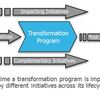By: Steve Blackshaw, IP Transformation Product Line Management, Alcatel-Lucent
IP Technology Programs are primarily focused on delivering technology solutions. However, the goal ultimately is to launch new services, and substitute old ones for all IP services. How do we ensure our technical visions deliver on these more marketing driven needs?
We need to ask… “Why Are We Building The Network?”
With IP Transformation programs sponsored and funded by the CTO, delivered by technology-focused teams, and culturally embedded within network operations, it is easy to forget that the over-riding objective of many programs is to actually change the service portfolio mix, for the benefit of both customers, and the provider.
So, how can Service Portfolio managers ensure that this vision is not lost when the programs are so heavily influenced by technology?
Step-forward…Marketing Are Sponsors Too!
The first step is to ensure that marketing (and service portfolio owners) are identified as key sponsors at the outset of the program. This is often missed when the needs of marketing are identified late in the process (during delivery), often halting the program, until the priority between technology requirements (decommissioning and cost saving) are balanced with those of services (new product launch and portfolio consolidation). The late impact of failing to recognize the central role of the services portfolio can be costly and embarrassing.
Avoid the Road To Nowhere.
Without a clear service roadmap, the program is on a road to nowhere. A service roadmap lays out the direction for service change, and ultimately derives the technical and migration priorities. In setting out a service roadmap, several considerations have to be undertaken by the portfolio team:
When analyzing each existing service, the roadmap accounts for 4 outcomes post analysis:
- Legacy Mapping to IP takes into accounts all those services that will map to equivalent IP services
- Retirements accounts for all those services that will be withdrawn
- Service Substitution accounts for all those services that will be replaced with an alternative market offer
- New Services accounts for all those services that will be launched using the new IP capability
Each of these requires specific consideration in planning the program, prior to technology planning.
Legacy Mapping
Legacy mapping is the staple of IP Transformation programs. It is the migration of existing services to IP equivalent circuits. Whilst the protocol (transport, edge devices , and in some cases, CPE) may change, the actual service offering is within contractual boundaries of equivalence. The service team will still need to determine the customer impact (during and post migration) and if the service is still delivered, managed and priced correctly in an IP world.
Retirements
Service retirement is often discussed by network operators, but rarely executed, due to the brand issues in disrupting paying customers, and subsequent loss of revenue stream. However, the business case for IP Transformation often predicates the removal of legacy equipment, and older services with diminished user base are often loss leaders halting legacy removal. IP Transformation gives a one in a decade opportunity to finally retire those services. It takes significant account planning, and a combined executive will, but it can be done.
Service Substitution
Service Substitution replaces those services where emulation (equivalency) is not possible. In essence, the service managers identify services that can substitute similar business features of legacy ones, and position those with customers. Financial modeling and customer demographic analysis is necessary to determine the compelling adoption point (to achieve take up rates), supported by an orchestrated account management policy to engage customers and meet the program timelines.
New Service Launches
New services (or expansions to existing services) are enabled through the introduction of IP Networks. The roadmap should be used to identify which customers will be targeted, where and when, to enable new product launches during the IP Transformation timeline.
Bring It All Together.
Only when the service roadmap has been defined can the technology and migration programs be shaped and prioritized. The service roadmap defines the order in which technology is deployed, the geographies, user groups and engagement strategy. Without a service roadmap, the business case itself is called into question - which is why the roadmap is authored prior to the financial budgets.
The Service Roadmap – The Heart Of IP Transformation
We started this blog by stating that IP Transformation programs are technology-centric. In nature, they are, but at their heart lies the driver for a new service roadmap. Whilst technology is an enabler, the program outcomes are all about marketing, customer demand and return on the investment.
To learn more, please download the white paper “Better business case management for IP Transformation.” And, for more information on creating an effective business case for IP Transformation, please see our earlier blog on TMCnet, “The Business Case for IP Transformation: Creating the Case.”












